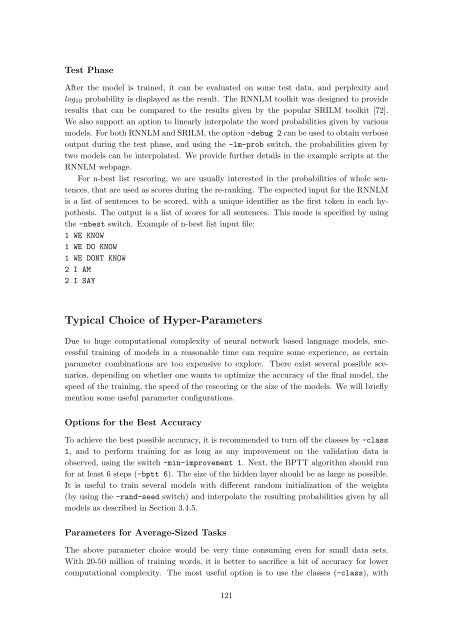Statistical Language Models based on Neural Networks - Faculty of ...
Statistical Language Models based on Neural Networks - Faculty of ...
Statistical Language Models based on Neural Networks - Faculty of ...
You also want an ePaper? Increase the reach of your titles
YUMPU automatically turns print PDFs into web optimized ePapers that Google loves.
Test Phase<br />
After the model is trained, it can be evaluated <strong>on</strong> some test data, and perplexity and<br />
log10 probability is displayed as the result. The RNNLM toolkit was designed to provide<br />
results that can be compared to the results given by the popular SRILM toolkit [72].<br />
We also support an opti<strong>on</strong> to linearly interpolate the word probabilities given by various<br />
models. For both RNNLM and SRILM, the opti<strong>on</strong> -debug 2 can be used to obtain verbose<br />
output during the test phase, and using the -lm-prob switch, the probabilities given by<br />
two models can be interpolated. We provide further details in the example scripts at the<br />
RNNLM webpage.<br />
For n-best list rescoring, we are usually interested in the probabilities <strong>of</strong> whole sentences,<br />
that are used as scores during the re-ranking. The expected input for the RNNLM<br />
is a list <strong>of</strong> sentences to be scored, with a unique identifier as the first token in each hypothesis.<br />
The output is a list <strong>of</strong> scores for all sentences. This mode is specified by using<br />
the -nbest switch. Example <strong>of</strong> n-best list input file:<br />
1 WE KNOW<br />
1 WE DO KNOW<br />
1 WE DONT KNOW<br />
2 I AM<br />
2 I SAY<br />
Typical Choice <strong>of</strong> Hyper-Parameters<br />
Due to huge computati<strong>on</strong>al complexity <strong>of</strong> neural network <str<strong>on</strong>g>based</str<strong>on</strong>g> language models, successful<br />
training <strong>of</strong> models in a reas<strong>on</strong>able time can require some experience, as certain<br />
parameter combinati<strong>on</strong>s are too expensive to explore. There exist several possible scenarios,<br />
depending <strong>on</strong> whether <strong>on</strong>e wants to optimize the accuracy <strong>of</strong> the final model, the<br />
speed <strong>of</strong> the training, the speed <strong>of</strong> the rescoring or the size <strong>of</strong> the models. We will briefly<br />
menti<strong>on</strong> some useful parameter c<strong>on</strong>figurati<strong>on</strong>s.<br />
Opti<strong>on</strong>s for the Best Accuracy<br />
To achieve the best possible accuracy, it is recommended to turn <strong>of</strong>f the classes by -class<br />
1, and to perform training for as l<strong>on</strong>g as any improvement <strong>on</strong> the validati<strong>on</strong> data is<br />
observed, using the switch -min-improvement 1. Next, the BPTT algorithm should run<br />
for at least 6 steps (-bptt 6). The size <strong>of</strong> the hidden layer should be as large as possible.<br />
It is useful to train several models with different random initializati<strong>on</strong> <strong>of</strong> the weights<br />
(by using the -rand-seed switch) and interpolate the resulting probabilities given by all<br />
models as described in Secti<strong>on</strong> 3.4.5.<br />
Parameters for Average-Sized Tasks<br />
The above parameter choice would be very time c<strong>on</strong>suming even for small data sets.<br />
With 20-50 milli<strong>on</strong> <strong>of</strong> training words, it is better to sacrifice a bit <strong>of</strong> accuracy for lower<br />
computati<strong>on</strong>al complexity. The most useful opti<strong>on</strong> is to use the classes (-class), with<br />
121







